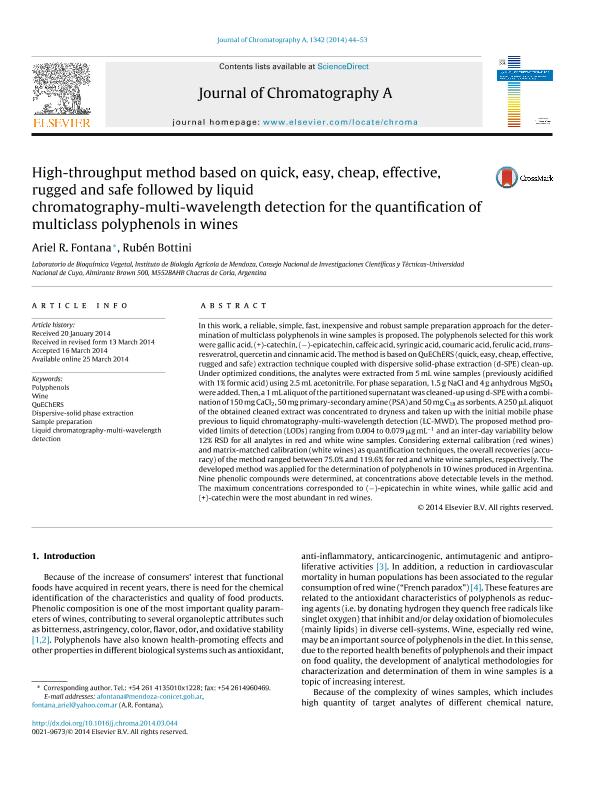Artículo
High-throughput method based on quick, easy, cheap, effective, rugged and safe followed by liquid chromatography-multi-wavelength detection for the quantification of multiclass polyphenols in wines
Fecha de publicación:
03/2014
Editorial:
Elsevier
Revista:
Journal of Chromatography - A
ISSN:
0021-9673
Idioma:
Inglés
Tipo de recurso:
Artículo publicado
Clasificación temática:
Resumen
In this work, a reliable, simple, fast, inexpensive and robust sample preparation approach for the determination of multiclass polyphenols in wine samples is proposed. The polyphenols selected for this work were gallic acid, (+)-catechin, (-)-epicatechin, caffeic acid, syringic acid, coumaric acid, ferulic acid, trans-resveratrol, quercetin and cinnamic acid. The method is based on QuEChERS (quick, easy, cheap, effective, rugged and safe) extraction technique coupled with dispersive solid-phase extraction (d-SPE) clean-up. Under optimized conditions, the analytes were extracted from 5 mL wine samples (previously acidified with 1 % formic acid) using 2.5 mL acetonitrile. For phase separation, 1.5 g NaCl and 4 g anhydrous MgSO4 were added. Then, a 1 mL aliquot of the partitioned supernatant was cleaned-up using d-SPE with a combination of 150 mg CaCl2, 50 mg primary-secondary amine (PSA) and 50 mg C18 as sorbents. A 250 µL aliquot of the obtained cleaned extract was concentrated to dryness and taken up with the initial mobile phase previous to liquid chromatography-multi-wavelength detection (LC-MWD). The proposed method provided limits of detection (LODs) ranging from 0.004-0.079 µg mL-1 and an inter-day variability below 12 % RSD for all analytes in red and white wine samples. Considering external calibration (red wines) and matrix-matched calibration (white wines) as quantification techniques, the overall recoveries (accuracy) of the method ranged between 75.0 % and 119.6 % for red and white wine samples, respectively. The developed method was applied for the determination of polyphenols in 10 wines produced in Argentina. Nine phenolic compounds were determined, at concentrations above detectable levels in the method. The maximum concentrations corresponded to (-)-epicatechin in white wines, while gallic acid and (+)-catechin were the most abundant in red wines.
Archivos asociados
Licencia
Identificadores
Colecciones
Articulos(IBAM)
Articulos de INST.DE BIOLOGIA AGRICOLA DE MENDOZA
Articulos de INST.DE BIOLOGIA AGRICOLA DE MENDOZA
Citación
Bottini, Ambrosio Rubén; Fontana, Ariel Ramón; High-throughput method based on quick, easy, cheap, effective, rugged and safe followed by liquid chromatography-multi-wavelength detection for the quantification of multiclass polyphenols in wines; Elsevier; Journal of Chromatography - A; 1342; 3-2014; 44-53
Compartir
Altmétricas




